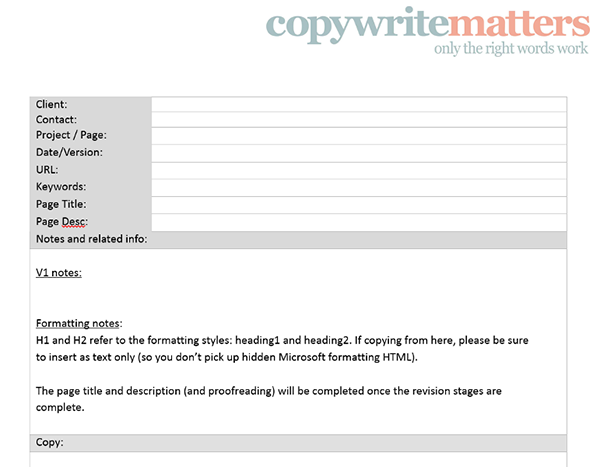The smart copywriter’s guide to copy decks: presenting your copywriting (so your client loves you before they read it)
I’ve been asked about copy decks in the last few monthly coaching calls for my Copywriting Master Class students. When I’m asked something more than twice, it’s an invitation to pop on the Copy Detective’s hat and cape and shout, TO THE BLOG!
So, here we are. This post breaks down what a copy deck is and why it’s an essential template in a professional copywriter’s arsenal.
Table of Contents
What is a copy deck?
A copy deck is the template for the presentation of your copywriting. It contains all of the information your client needs in relation to the copy you’re handing over.

I think the term ‘copy deck’ has roots in ‘Agency Land,’ but every freelance copywriter I know uses some kind of document template for every piece of copywriting they hand over.
Can’t you just bung your copy into a document and email it over?
Well, yes, you can do that. But what happens when your copy is printed out and popped onto a desk, along with 30 other documents to be read, and then shuffled around? Your client picks it up and vaguely remembers it’s their website copywriting but… Who wrote it again? When was it sent through? Is it the final version?
Confusion reigns!
A good copy deck serves a few purposes.
- It makes it easy for clients to read the copy.
- It makes it easy to implement the copy.
- It makes you look professional.
What goes into a copy deck?
I like to keep my copy deck relatively simple. I don’t overload it with too much information in case it distracts my client from the words I’m presenting.
Each component of my copywriting is presented in a table with the following headers:
- Project name
- Client business name
- Contact person
- Date of delivery plus version, e.g., 01/07/2015 V1 (of 3)
- Notes
- The copy
The first four are pretty obvious, but they are important to keep track of what you’re doing. This becomes essential if you’re working on multiple projects for the same client.
I also include notes for each piece of copywriting.
If we’re into the revision stage, those notes cover what was requested and what has changed. Sure, I could just track the changes so they can see what has changed, but I find that tracking changes becomes distracting if there are more than a few small changes.
You don’t want to distract your client from your copywriting.
If it’s the first version of the copywriting, I use the notes to recap what they asked for (objectives, tone of voice, etc.) and to explain my approach.
Remember, as a copywriter, you’ve been hired for your expertise. Sometimes, an idea or a turn of phrase can seem deceptively straightforward. That doesn’t mean it was easy or written without thought. It pays to explain your process and rationale to remind clients that your expertise is at work. If I have a lot of notes, I just pop them on a separate introduction page.
If I’m delivering online copywriting, I also include the following:
- Page URL
- Title and description tagsLinks
- Links
This is where the implementation comes in. Website developers need to know which anchor text will be a link and what the link address (URL) will be. I usually underline the text in the copy and then repeat it with the URL in a section under the copy.
I don’t believe you should embed URLs in the copy, because they will distract your client from the copywriting. Can you see a theme emerging?
Reinforce your professionalism
I’m talking about branding. Every single document you give a client should be branded like a MOFO and include your contact details.
Why? There is the functional aspect of making sure your client knows who wrote their copy and how they can contact you. By putting your branding and contact details on every page, you make it easy for your clients to do that.
Making life easier for your copywriting clients shows you care. And the branding helps you look professional.
Want to level up your copy deck?
All of the elements I’ve listed so far are pretty much essential for a basic copy deck. The purpose of this information is to make sure your client understands the copy in front of them and to make it easy to implement once it’s approved.
The easier you can make the revision and implementation process, the better! As I said, making life easier for your clients shows you care. And that’s what will get you repeat business.
So, if you want to level up your copy deck, include instructions or tips on the review process.
Why? Because many people don’t know how to give effective feedback.

When a client has no framework within which to give you feedback, they’ll often say, “I don’t like it, but I can’t tell you why.” This is no good for you as the copywriter. No good at all.
And it’s not the client’s fault! If you want helpful feedback on your copywriting, show them how to give it. Your copy deck is a great place for that advice, because it’s with the copy.
It could be as simple as,
To give us the best final draft possible, please consider the following questions as you review the copy:
- Are all of the facts correct?
- Is anything missing?
- Should any information be removed?
- Are there any awkward passages or transitions?
- Are all of the features and benefits explained clearly?
- Does the style, tone and vocabulary fit your target audience?
If there is any copy that you don’t like, please add some notes explaining why so we can target the revisions appropriately.
(Feel free to copy this list, by the way!)
Then, if your client doesn’t like your copywriting, they have some aspects to review more critically. This helps them articulate specifically what they don’t like. It also gives the clear signal that the review process is a process, not a quick read through with thoughts blurted out.
It can also be helpful to remind your client that they don’t have to rewrite copy they don’t like. They can leave that to you (that is why you’re getting paid after all!).
Create a template that works for you
My copy deck is a straightforward template refined over a few years. I have added information and then taken it out if I felt it was a distraction. I have also talked to other copywriters about their process and nabbed ideas from them.
Assume that your copy is going to get passed around. Make sure it’s clear what this copy relates to, who owns it and how to get in touch with you again. The role of the copy deck is to help you get your copywriting approved faster by making the review process as straightforward as possible.
Do you use a copy deck? Is yours different? Let me know! Maybe I can nab some of your great ideas ?
About the Author
Belinda Weaver is the founder of Copywrite Matters and copywriter behind The Copy Detective blog. If you want to be the FIRST to hear when her next copywriting master class course (so you can write better copy, faster) get on the master class prelaunch list.
Join me on www.copywritematters.com.au





Good advice for veterans and newbies alike.
I agree with James! Good stuff.
Thanks to you both. I appreciate you taking the time to let me know!
I agree!
This is a useful and comprehensive summary Belinda. Thanks very much. I enjoyed reading it – and will use it.